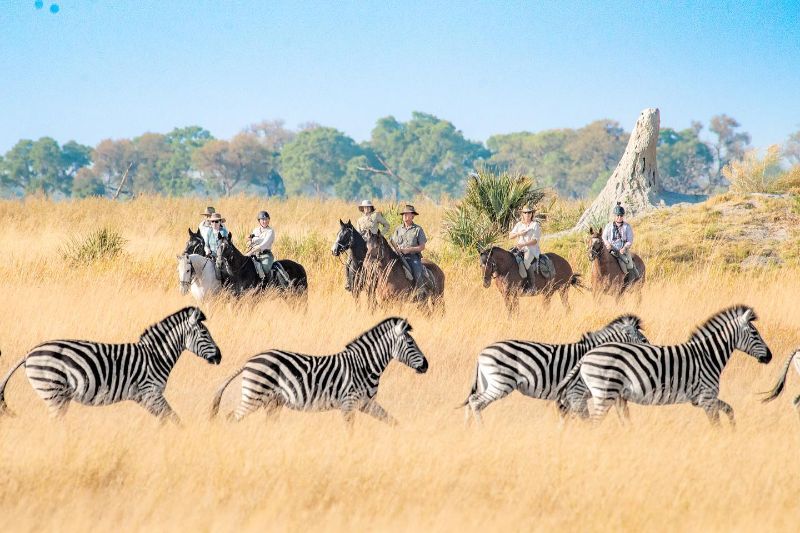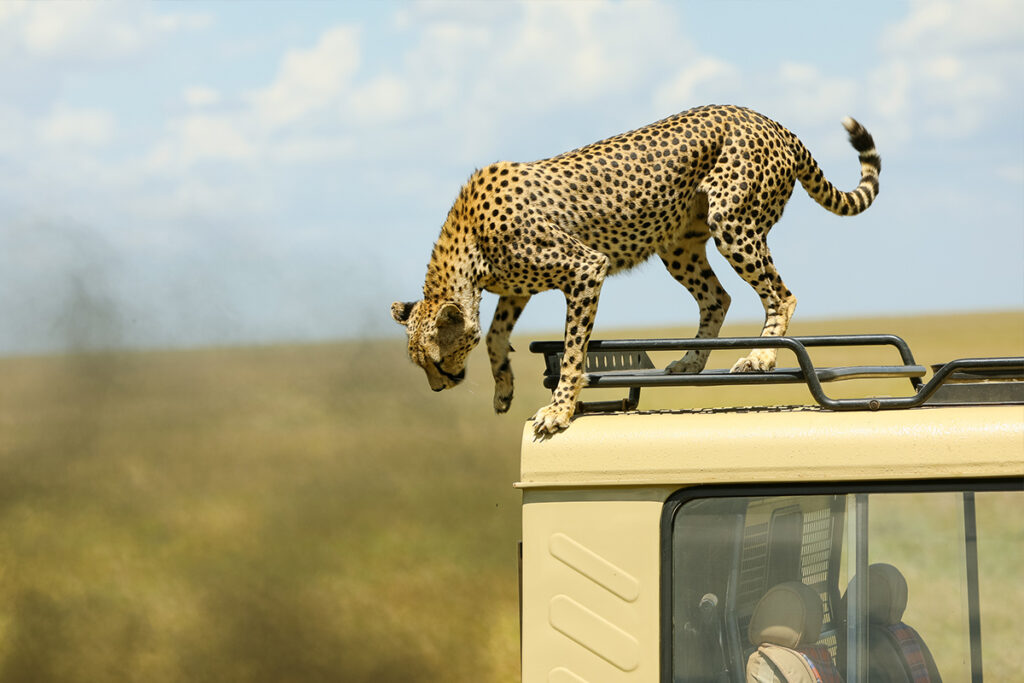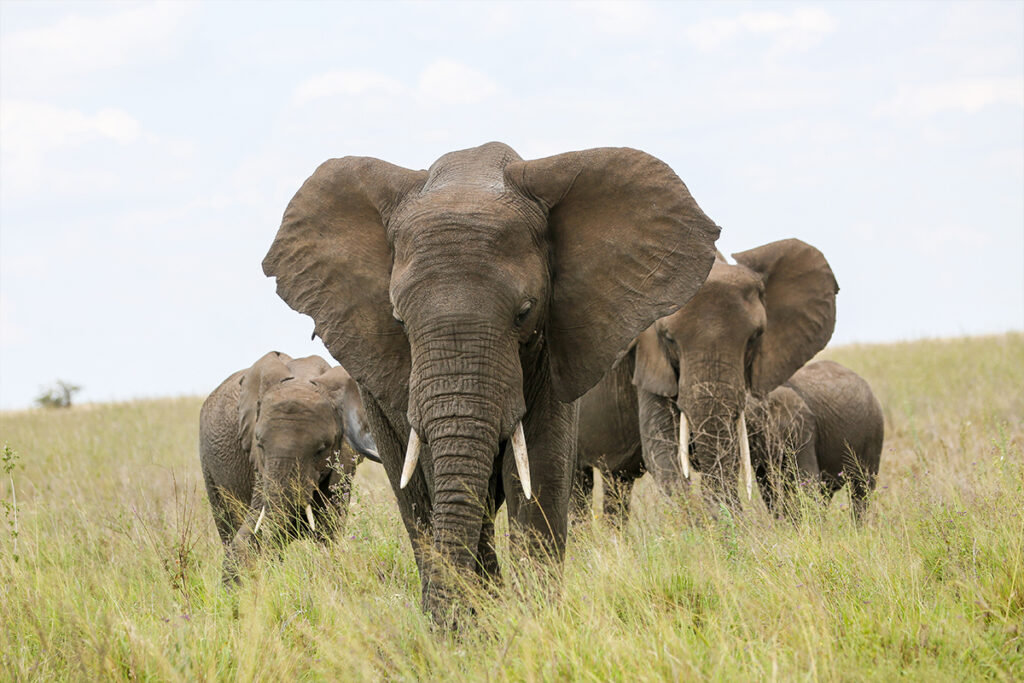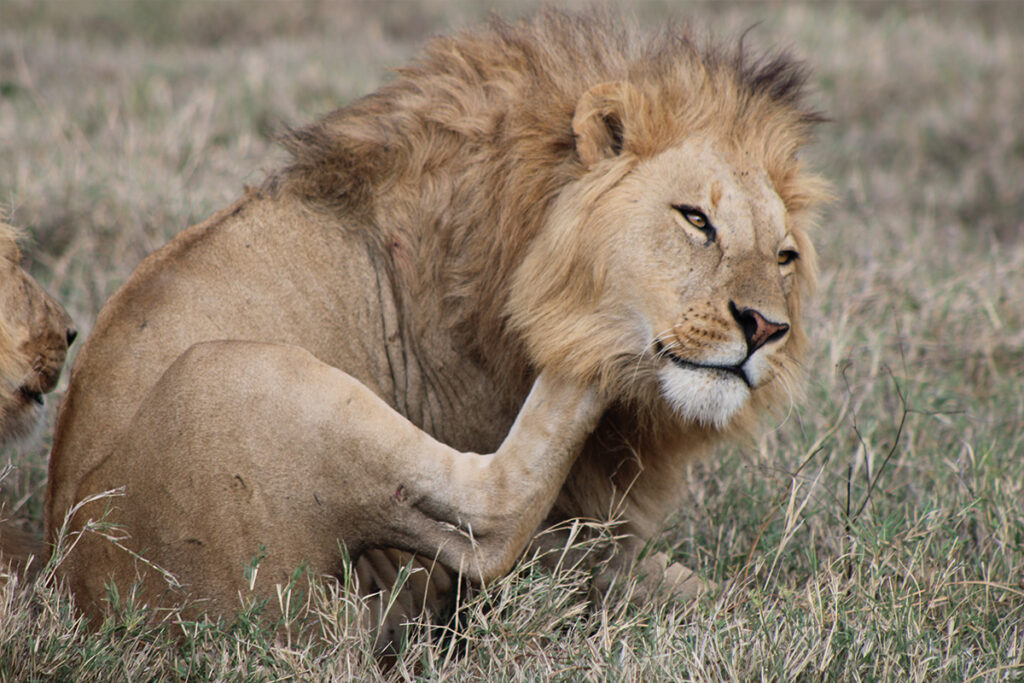Encountering zebras and giraffes from the saddle offers a unique perspective on the Tanzanian wilderness. This horseback safari provides a blend of thrill and tranquility, as you’re immersed in the rhythm of the African plains. It’s a seamless dance of nature, where each stride reveals the wild magnificence of Tanzania.
Tracing back to visionary conservation efforts, these safaris are now essential for sustainable tourism in Tanzania. Expertly guided, they offer insights into the ecology and wildlife management that have flourished. With over 16% of Tanzania’s land dedicated to conservation areas, such experiences are a testament to the region’s commitment to preserving its natural heritage.

Unique Experiences on a Tanzania Horseback Safari
Riding through the vast plains of Tanzania offers an unmatched connection with nature. As you traverse this open landscape, zebras and giraffes become your companions, providing breathtaking experiences. This safari introduces you to the Serengeti from an extraordinary perspective. The slow rhythm of the horseback ride lets you truly absorb your surroundings. Each moment feels like a scene from a nature documentary.
Guides leading the safari are experienced locals who know the terrain intimately. Their knowledge enriches your adventure, sharing stories and insights about the wildlife you encounter. You will learn about animal behaviors and conservation efforts directly from those who live it daily. This interaction adds depth to the trip. It’s not just a ride; it’s an educational journey.
Witnessing wildlife up close while on horseback is a thrill unlike any other. Imagine seeing a family of giraffes gently moving, or zebras grazing nearby. These moments are unique because you’re part of the environment, not just a spectator. The animals see you as less of a threat while on horseback. Thus, you get closer than on a typical safari drive.
These safaris vary, catering to different levels of riding experience. Whether you’re an expert rider or a beginner, there’s a package for you. Equipment and safety guidelines are always a priority. Lists mention suggested items to pack for the ride:
- Comfortable clothing
- Protective headgear
- Riding boots
- Sunscreen
- Insect repellent
Riding among giraffes and zebras
Imagine the thrill of riding a horse beside a tower of giraffes. Their graceful strides mirror the ease of your horse’s movement. As you venture deeper into their habitat, giraffes may pause to observe you curiously. It’s an incredible feeling to be so close to these gentle giants. The experience is both calming and exhilarating.
Zebras, with their striking stripes, often graze nearby. They might playfully dart away or stand peacefully, eating grass. This serene setting allows for a unique perspective of zebra behavior. Being on horseback makes you part of their world. It’s a rare and memorable experience.
Such encounters with wildlife are a photographer’s dream. A camera captures the harmony between horse, rider, and animal. Pictures serve as vivid reminders of the adventure. Remembering to stay quiet is crucial, allowing animals to remain undisturbed. Lists of wildlife to watch for include:
- Antelope
- Wildebeest
- Lions in the distance
- Colorful birds
Sustainable tourism efforts support these unique adventures. The impact benefits both the environment and local communities. By choosing horseback safaris, tourists help protect the habitats of these animals. This ensures future generations can share similar experiences. Riding with giraffes and zebras becomes a contribution to conservation.
Experiencing the Serengeti from horseback
Exploring the Serengeti on horseback offers a unique vantage point. The vast savannah spreads out like a golden sea, alive with wildlife. Riding here feels like stepping back in time, witnessing nature untouched. As you ride, the rhythm of hooves on the ground blends with the sounds of the wild. It’s an adventure that connects you deeply to the landscape.
The Serengeti teems with life, making each ride an exciting journey. Lions might quietly watch from afar, while herds of wildebeest move across the plains. This proximity to such diverse wildlife is awe-inspiring. Guides ensure that each encounter is respectful and safe. Your interest in the animals fuels a learning experience that’s unforgettable.
The absence of vehicle noise allows the natural sounds of the Serengeti to come alive. Birds chirp melodiously, while the wind whispers through the grass. The peaceful atmosphere enhances the sense of freedom that comes with horseback exploration. This tranquility is contrasted with the exhilarating rush when animals burst into motion. Combining quiet observation with thrilling moments makes each ride exceptional.
Preparing for this adventure involves careful planning. Essential items include:
- Riding helmets
- Sturdy boots
- Lightweight clothing
- Binoculars for spotting distant wildlife
Join a horseback safari to experience a truly remarkable side of the Serengeti.
Guided tours with experienced locals
Local guides bring invaluable knowledge to your horseback safari experience. Their expertise ensures every ride is both safe and informative. They know the terrain like the back of their hands, providing fascinating insights into the Serengeti’s ecosystem. As you follow their lead, you’ll discover hidden spots you might have missed otherwise. These guides share stories that enrich your understanding of the land.
Understanding animal behaviors and tracking them is a skill these guides excel at. They can identify subtle signs of wildlife activity, enhancing your chances of spotting elusive animals. Their keen eyes pick up on details that an untrained observer could overlook. This expertise turns every ride into a learning opportunity. Engaging with these guides makes the safari more interactive and personal.
Experienced guides aren’t just experts in wildlife. They are also well-versed in the community’s culture and history. This knowledge adds depth to your journey, connecting you to the local people and their traditions. Engaging stories about the land and its people unfold during the ride. These tales create a rich tapestry of experiences beyond just wildlife.
A guided tour also provides comfort and security. You can focus on exploring and enjoying the ride, knowing you’re in capable hands. This peace of mind allows you to immerse fully in the adventure. These experts handle any unexpected situations with skill. Your safety and enjoyment are their top priorities.
Choosing a guided tour supports local communities as well. It empowers residents and fosters sustainable tourism. By selecting local guides, you contribute to preserving both cultural and natural heritage. This choice ensures the Serengeti remains a vibrant habitat for generations. Lists of other tasks guides may assist with include:
- Camp setup and management
- First-aid skills and emergency readiness
- Knowledge of local flora and fauna
- Coordination of safari logistics
Seeing wildlife up close in their natural habitats
Experiencing wildlife in their natural habitats is a breathtaking opportunity. On a horseback safari, you become part of the landscape, blending in with the environment. This unique approach allows animals to behave naturally, giving you the chance to see them as they truly are. It’s quite different from a vehicle tour, where noise often keeps animals at a distance. This closeness enriches the safari experience immensely.
Imagine observing a herd of elephants enjoying a waterhole up close. Their playful splashes and gentle interactions reveal the social dynamics within the group. Meanwhile, lions may rest in the shade, showcasing their majestic presence. These sights of the Serengeti come to life when you’re not confined to a car. The intimacy of such encounters is unmatched.
The thrill of spotting a cheetah sprinting across the plains is unforgettable. Witnessing the world’s fastest land animal in action is both exhilarating and educational. You learn about predator-prey relationships and how the ecosystem balances itself. Each sighting reminds you why preserving these natural habitats is crucial. The Serengeti’s diverse wildlife presents endless discoveries.
Experiencing wildlife like this requires certain guidelines. Keeping a respectful distance ensures animals remain undisturbed. Additionally, maintaining silence while observing allows for more genuine interactions. Guides emphasize the importance of safety and respect:
- No sudden movements
- Staying with the group
- Following guide instructions
- Avoiding flash photography
This close connection with wildlife creates lasting memories. Each unique encounter deepens your appreciation for nature’s wonders. It’s an adventure that inspires conservation efforts and fosters a greater understanding of the world. Being so close to wildlife reminds us of the beauty and fragility of these environments. Sharing these experiences helps spread awareness about the importance of protecting them.
The Impact of Horseback Safaris on Wildlife Conservation
Horseback safaris have a significant positive impact on wildlife conservation. By choosing this low-impact mode of exploration, tourists help reduce the carbon footprint typically associated with vehicle safaris. This choice assists in maintaining the serenity of the environment, allowing animals to thrive naturally. Quiet rides keep the disturbance to wildlife minimal. This harmony between tourism and nature is essential for sustainable conservation efforts.
The revenue from horseback safaris plays a crucial role in funding conservation initiatives. Local communities rely on these funds to support various projects aimed at protecting wildlife and their habitats. These financial resources are often directed towards anti-poaching patrols and habitat restoration projects. Encouraging eco-friendly tourism ensures the long-term survival of numerous species. Every safari taken contributes to these vital efforts.
Educational opportunities arise as travelers learn about the importance of conservation. Guides use this platform to inform visitors about current challenges facing wildlife. They discuss topics such as habitat loss and the steps taken to combat these issues. Education through experience creates awareness. This knowledge prompts action and global support for protection measures.
Horseback safaris also foster a deeper connection with nature. When individuals experience the astounding beauty of wildlife firsthand, they are more likely to advocate for its preservation. This emotional bond is powerful in nurturing conservation-minded behaviors. Moreover, these safaris help bridge the gap between humans and wildlife. People leave with a sense of responsibility to protect what they’ve witnessed.
Their impact extends beyond environmental benefits. Job creation within local communities is fueled by the demand for skilled guides and support staff. This economic support imbues residents with a sense of pride in preserving their land and heritage. Lists of benefits include:
- Reduced environmental impact
- Financial support for conservation projects
- Increased education and awareness
- Enhanced emotional connection to nature
- Job creation for locals
Choosing the Right Safari Package for Your Adventure
Selecting the perfect safari package is crucial for a memorable adventure. Various packages cater to different preferences and experience levels. Beginners might want shorter, guided rides, while experienced riders may opt for extended excursions. It’s important to consider the time you want to spend in the saddle. Packages vary greatly and can be customized to meet your needs.
Cost is another critical factor when choosing a safari package. While luxury options offer all-inclusive amenities, there are budget-friendly choices too. It’s essential to balance luxury with affordability. Some packages include additional activities like walking safaris or night drives. Comparing prices and inclusions will help you find the best deal.
Reviewing customer feedback can provide valuable insights into each package’s quality. Reading reviews helps identify reliable operators and highlight any potential issues. Look for testimonials about guide expertise, accommodation standards, and overall satisfaction. Websites often list:
- Tour duration
- Included meals
- Wildlife spotting opportunities
- Group sizes
The diversity of wildlife encountered on different tours should also influence your decision. Specific areas within Tanzania offer varied animal sightings and unique landscapes. Think about what species you are most eager to see up close before selecting a location-specific tour package. Consulting with tour operators can help match your interests with the right route.
If traveling with family or friends, ensure the chosen package suits everyone’s interests and abilities. Some safaris are more family-friendly than others, offering activities suited for children and older adults alike. Group discounts might be available which further enhances value for money spent on these adventures.
What to Prepare Before Your Horseback Safari
Before embarking on a Tanzania horseback safari, proper preparation is essential. Packing the right gear ensures comfort and safety throughout your journey. Sturdy, comfortable boots and a helmet are must-have items. Lightweight clothing in layers is ideal for changing weather conditions. Don’t forget sunscreen and a hat to protect against the sun.
Fitness is another key consideration due to the nature of the activity. Ensuring you are in good physical condition will make your experience more enjoyable. Regular horseback riding practice before your trip helps. It’s advisable to join some riding lessons if you are a beginner. Strength and flexibility exercises can also be beneficial.
Documentation and health precautions should be in place well before departure. Check if your passport is up to date and whether you need a visa for Tanzania. Vaccinations may be required; consult with a healthcare provider to get the necessary shots. Carrying travel insurance that includes adventure activities is wise. Lists of essential documents include:
- Passport and visa
- Travel insurance
- Vaccination records
- Riding certification (if required)
Understanding and following safari guidelines ensures both you and the wildlife are safe. Familiarize yourself with rules provided by your tour operator. Maintain a respectful distance from animals and follow your guide’s instructions. This helps to minimize stress on wildlife and ensures an ethical safari experience. Proper preparation makes your horseback safari both safe and memorable.
Finally, packing extra essentials can enhance your comfort. Items such as a reusable water bottle, insect repellent, and binoculars are useful. A small backpack to carry personal items during rides keeps everything accessible. Keep in mind that some of these items might be provided by the tour operator. Still, having your own ensures personal preferences are met.
Key Takeaways
- Experience the Serengeti’s wildlife up close on horseback safaris.
- Ride alongside majestic zebras and towering giraffes in their habitats.
- Guided tours offer professional insights and ensure safety.
- Sustainable tourism helps protect Tanzania’s diverse ecosystems.
- This adventure combines education with thrilling exploration.



